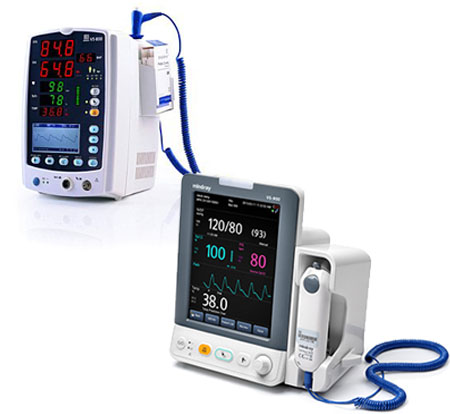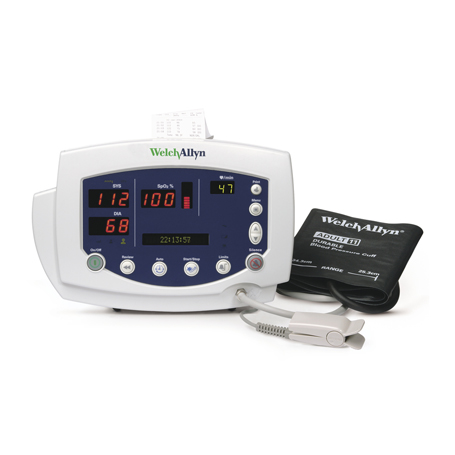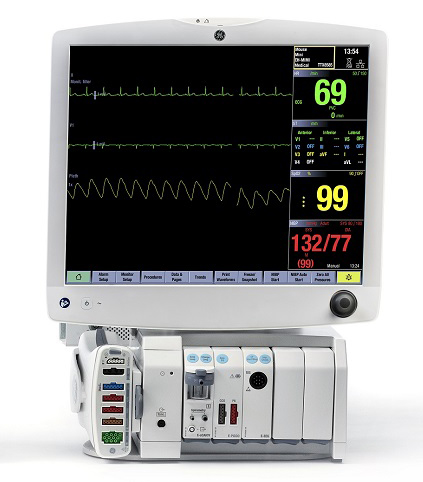Solutions for Vital Signs Monitors (VSM) parts and supplies
Keep always in check the vital signs of your patients, in Meditegic we offer a wide selection of vital signs monitors, replacement parts, supplies and general monitoring equipment such as screens and displays, cables and sensors, circuit boards and battery packs among many others.
- Evaluate your patients at all times and in a complete manner.
- Be able to analyze the ECG curves physically or with remote attention.
- Detect, process and continuously display the physiological parameters of your patients.
- Have an alarm system that alerts when there is an adverse situation outside the desired limits.
Our commercial infrastructure enable us to operate as a bi-national company with global supply reach, we can offer any of the models announced on this website with a fast delivery service to more than 28 countries, this gives us the confidence to bring security to our customers by letting them know that these monitors will be in optimal conditions, they are available by brand names including GE, Datex Ohmeda, Siemens, Philips and many more. If you need a specific monitor please contact us!

Vital signs monitors for the most requested systems:
- Monitors for specialization areas such as intensive therapies for adults, coronary and neonatal
- Monitors for operating rooms and recovery
- Monitors for emergencies (ER)
- Monitors for transport
- Anesthesia basic/advanced monitors
- Forensic monitors
-
Download our Monitors Brochures & Service Manuals
- Abbott Gemstar Service Manual
- Aesculap EndoVue Surgical Displays
- Criticare Vitalcare 506N3 Service Manual
- Drager 8060PM Vitara Patient Monitor User Manual
- GE CIC Pro Service Manual
- Nihon Kohden OPV-1500 Bedside Monitor Service Manual
- Nihon Kohden Cardiofax ECG-9620 Repair Manual
- Siemens Servo Screen 390 Service Manual
- Nihon Kohden BSM 4100 Service Manual
- Nihon Kohden BSM 2300 Service Manual
- Nihon Kohden BSM-5100 Bedside Monitor Service Manual
- Nihon Kohden CNS-9701 Central Monitor Service Manual
- Nihon Kohden ECG-9010 Monitor Service Manual
- Nihon Kohden BSM-9510 Bedside Monitor Service Manual
- Siemens Servo-i Service Manual
Gallery
Supplies and medical consumables for monitoring equipment:
- Blood Pressure and Pulse Monitors supplies and consumables
- LCD Screens and Displays for VSM and Patient Monitors
- Front Pannels for VSM and Patient Monitors
- Cables and Sensors (Connectivity Accesories; Nurse Call Cable, Ethernet, USB, Battery Adaptor Cable and more (just ask our sales representant)
- Circuit Boards and Assemblies for VSM and Patient Monitors
- Spare Battery Packs (Batteries) for VSM and Patient Monitors
- Mobile Basket Stands for VSM and Patient Monitors
- Cleaning and Service Kits for VSM and Patient Monitors
- Adult and Pediatric Medical SpO2 Sensors for VSM and Patient Monitors
- Adult, Pediatric, Infant and Neonate NIBP Hoses for VSM and Patient Monitors
- Connectors and tubing accesories for VSM and Patient Monitors
- Neonatal Finger Clips
- Blood Pressure Cuffs

Vital signs monitor's specifications
-
If you are looking for a VSM model that is not listed here, please contact us.
- GE Datex Ohmeda S/5 Anesthesia Monitor
- Datex Ohmeda S5 Vital Signs Monitor
- Datex Ohmeda Cardiocap 5 Multiparameters
- CARESCAPE Monitor B850
- CARESCAPE VC150 Vital Signs Monitor
- GE Datex Ohmeda Cardiocap/5 Anesthesia Monitor
- Datex Ohmeda Cardiocap II Multiparameters
- Datex Satlite Trans Oximeter
- CARESCAPE Monitor B650
- GE B40 Patient Monitor
- GE Datex Ohmeda Cardiocap/5 Patient Monitor
- Datex Ohmeda 3800 Pulse Oximeter
- GE Dash 2000 Multiparameters Monitor
- CARESCAPE Monitor B450
- CARESCAPE V100 Monitor
- Intensive care multi-parameter monitor / transport / CO2 / EEG BeneView Tx series
- Multi-parameter transport monitor / TEMP / SpO2 / NIBP MEC series
- Hand-held pulse oximeter / with separate sensor PM-60
- Multi-parameter transport monitor / CO2 / TEMP / SpO2 iPM series
- Intensive care vital signs monitor / SpO2 / TEMP / NIBP VS-900
- Central patient monitoring station / 64-bed Hypervisor VI
- Anesthesia multi-parameter monitor / NIBP / SpO2 / ECG iMEC series
- Intensive care vital signs monitor / NIBP / SpO2 / TEMP VS-600
- CMS8000 Patient Monitor
- CMS7000 Patient Monitor
- CMS5100 Patient Monitor
- CMS9000 Patient Monitor
- HMS6500 Multi-parameter Vital Signs Monitor
- CMS5000C Patient Monitor
- CMS06C Patient Monitor
- CMS9200 Patient Monitor
- CMS5000 Patient Monitor
- CM400 PC Monitoring Module
- CMS7000PLUS Patient Monitor
- CMS9200PLUS Patient Monitor
- PM60A Patient Monitor
- CMS6000 Patient Monitor
- CMS6800 Patient Monitor
- HMS9800 Multi-parameter Vital Signs Monitor
- CMS6500 Patient Monitor
- Surveyor Central
- Q-Tel
- Propaq CS Monitor
- Acuity LT Central Monitoring Station
- Connex Vital Signs Monitor
- Surveyor S12/S19
- Spot Vital Signs Device
- Propaq Encore Monitor
- Connex Clinical Surveillance Systems
- Surveyor S4 Wearable Patient Monitor
- Connex ProBP 3400 Digital Blood Pressure Device
- Vital Signs Monitor 300 Series
- Spot Vital Signs LXi Devices
- Propaq LT Monitor
- ProBP 2400 Digital Blood Pressure Device
- 1500 Patient Monitor
- Connex Spot Monitor
- Philips Intellivue MP50
- Philips Intellivue MP60
- Philips Intellivue MP70
- Philips M2636B Telemon M2601A
- Philips M1204 Series Monitor
- Philips M2636C Telemon C
- Philips M2636B Telemon B
- Philips M3 Series Monitor
- Philips M3002A (X2) Monitor
- Philips M4 Series Monitor
- Philips Intellivue MP20
- Philips Intellivue MP30
- Philips Intellivue MP40
- OMNI II
- OMNI K
- OMNI III
- CLEO vital signs monitor
- OMNI
- OMNI EXPRESS
- Infinium O2 Sat
- BM3 patient monitor
- FC700 fetal monitor
- FC 1400 fetal monitor
- Siemens SC7000 Multiparameters Monitor
- Siemens SC 7000 Vital Signs Monitor
- Siemens SC 9000 XL Vital Signs Monitor
Basic monitors
-
VSM basic specifications
- Monitor configured or modular with screen of 8 inches minimum.
- Deployment of physiological curves of: At least 3 simultaneous curves.
- ECG.
- O2 saturation.
- Plethysmography.
- Breathing.
Intermediate monitors
-
VSM intermediate specifications
- Monitor configured or modular with screen of 8 inches minimum.
- Deployment of physiological curves of: At least 4 simultaneous curves or 6 according to growth options.
- ECG.
- O2 saturation.
- Plethysmography.
- Breathing.
- Optional: Capnography, invasive pressure, cardiac output by thermodilution.
Advanced monitors
-
VSM advanced specifications
- Modular monitor with at least 15-inch screen.
- Deployment of physiological curves of: At least 8 simultaneous curves.
- ECG.
- SpO2.
- Plethysmography.
- Breathing.
- Temperature.
- Non-invasive pressure.
- Invasive pressure.
- Capnography.
- Optional: EEG, bispectral index, cardiac output, spirometry.
Transport monitors
-
VSM transport specifications
- For use in ambulance, extra-hospital transportation, intra-hospital transportation.
- Configured or modular monitor with a minimum screen of 5.8 inches.
- 8V power for ambulance.
- At least 3 simultaneous curves.
- ECG.
- O2 saturation.
- Plethysmography.
- Breathing.
Anesthesia monitors
-
VSM anesthesia especifications
- Molded or preconfigured monitor with a minimum screen of 10.4 inches.
- Deployment of physiological curves of at least 6 simultaneous curves.
- ECG.
- SpO2.
- Plethysmography.
- Breathing.
- Temperature.
- Non-invasive pressure.
- Invasive pressure.
- Capnography.
- Anesthetic and respiratory gases.
- Optional: Spirometry, MAC curve display (minimum alveolar concentration), neuromuscular transmission, gas curve display.
Adv anesthesia monitors
-
VSM anesthesia adv specifications
- Modular monitor with at least 12-inch screen.
- Deployment of physiological curves of at least 8 simultaneous curves.
- ECG.
- SpO2.
- Plethysmography.
- Breathing.
- Non-invasive pressure.
- Invasive pressure.
- Capnography.
- Anesthetic and respiratory gases.
- Optional: Spirometry, MAC deployment (minimum alveolar concentration), neuromuscular transmission.
- Gas curve display, bispectral index, blood analysis, continuous non-invasive cardiac output, continuous invasive cardiac output, venous saturation, EEG, entropy.
We offer a wide supply of monitors for vital sign measuring:

- Calorimetry
- Carbon dioxide (CO2) both Sidestream and Mainstream
- Electrocardiogram (ECG), Arrhythmias
- Electroencephalography (EEG)
- Entropy
- Spirometry
- Inspired Oxygen fraction
- Breathing frequency rate
- Heart rate
- Anesthetic gases
- Cardiac output
- Biospectral index (BIS)
- Pulse oximetry
- Oxygen and transcutaneous carbon dioxide (tcpO2 and tcpCO2)
- Non-invasive pressure (PNI)
- Invasive pressure (IP)
- Blood pressure
- Intracranial pressure (ICP)
- Gas pressure in the airway (anesthesia)
- Breathing
- Oxygen saturation (SpO2)
- Venous oxygen saturation (SvO2)
- ST segment
- Body temperature
- Gastric tonometry
- Neuromuscular transmission (TNM)
Gallery
FAQ
-
What to evaluate to buy a monitor?
The purchase of monitoring equipment is a process that must be evaluated in detail from 6 to 8 months before the start-up of this unit. Among the considerations should be taken into account:
- Population of patients to be treated.
- Financial resources.
- Degree of specialization of the unit.
In addition, said purchase must contemplate a strategic plan for the future of at least 5 years.
Areas of expertise
For areas of specialization such as intensive therapies for adults, coronary and neonatal patients, it is suggested to think of modular monitors and with the deployment of at least 6 waveforms.
- Among the parameters suggested as a basis are recommended: electrocardiogram (ECG) with heart rate measurement, respiration, non-invasive pressure (PNI), one or two invasive pressure channels (PI), oxygen saturation (SpO2) plethysmography and temperature, in all equipment and 2 or 3 modules of cardiac output and CO2 per unit.
- Another application to consider is the system with algorithms approved by international organizations, for detection of arrhythmias such as the American Heart Association (AHA) and the Massachusetts Institute of Technology (MIT), as well as a reliable alarm system.
- It is suggested to monitor 12 electrocardiogram channels (ECG) and ST segment measurement in at least 3 channels.
- It is optionally suggested that the monitor can be connected to external equipment such as fans, infusion pumps, among others.
- Preferably these monitors should be connected to a monitoring center.
Operating rooms and recovery
In operating rooms and recovery areas, modular monitors are also recommended.
- These should be able to connect (through some interface) to the anesthesia machines in order to integrate and manage all the information from the patient monitor.
- The suggested parameters are: electrocardiogram (ECG) with measurement of heart rate, one or two channels of invasive pressure (IP), non-invasive pressure (PNI), oxygen saturation (SpO2) and plethysmography, cardiac output, CO2 measurement, 2 temperatures and preferably a module with at least two EEG channels.
- Preferably the monitor should be able to connect to the ventilator of the anesthesia machine to facilitate the integration of the data.
- It must have an anesthetic gas measurement module.
- A recorder module and a printer are also recommended.
-
What consumables should I consider?
• Electrodes, especially those associated with warm-ups (eg, electrodes for transcutaneous measurement of blood gases, TcPO2 and TcPCO2) should be changed periodically to avoid burns or skin irritations.
• The cables of each of the parameters, and especially those of the ECG leads, should be checked periodically to detect ruptures or false contacts.
• Caution should be exercised in the use of pulse oximeters, especially when electrosurgery systems are used because they generate high frequency signals that could affect the operation of the SpO2 sensor.
• The cables of the different parameters as well as the ECG lead wires should be protected as indicated by the FDA to avoid patient discharges.
• The alarms in the monitors give one of the main considerations and the users of these should be familiar in their auditory and visual differences since they will have to classify the different situations of the patient between very serious, moderate and of low risk.

